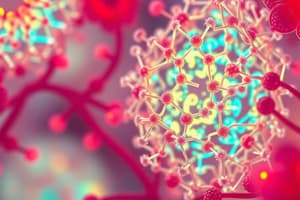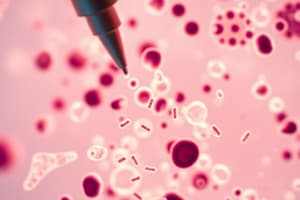Podcast
Questions and Answers
What is the primary purpose of vital examination in cell microscopy?
What is the primary purpose of vital examination in cell microscopy?
- To enhance the separation power of the microscope
- To examine living cells without damaging them (correct)
- To utilize high levels of harmful dyes for clarity
- To analyze dead cells using stains
Which type of microscope is specifically mentioned as being used in vital examinations?
Which type of microscope is specifically mentioned as being used in vital examinations?
- Transmission electron microscope
- Phase-contrast microscope (correct)
- Fluorescence microscope
- Scanning probe microscope
What is a significant characteristic of the phase-contrast microscope?
What is a significant characteristic of the phase-contrast microscope?
- It provides 3D images using holography.
- It enhances the contrast between various cell parts without staining. (correct)
- It increases the separation power of the microscope.
- It uses fluorescent dyes for staining cells.
Which technique is used to create differences in light intensity in a phase-contrast microscope?
Which technique is used to create differences in light intensity in a phase-contrast microscope?
What is the role of the calcite or quartz plates in interference microscopy?
What is the role of the calcite or quartz plates in interference microscopy?
Why are harmless dyes like neutral red used in vital examination?
Why are harmless dyes like neutral red used in vital examination?
Which of the following statements is accurate regarding the phase-contrast microscope?
Which of the following statements is accurate regarding the phase-contrast microscope?
Which examination method utilizes fixation as part of its analysis?
Which examination method utilizes fixation as part of its analysis?
What is the limitation of normal light microscopes regarding object visibility?
What is the limitation of normal light microscopes regarding object visibility?
Which parameter increases when the objective of a microscope is moved closer to the object?
Which parameter increases when the objective of a microscope is moved closer to the object?
How is the magnification of a microscope calculated?
How is the magnification of a microscope calculated?
What type of light source is used in fluorescence microscopes?
What type of light source is used in fluorescence microscopes?
Which of the following describes the process of fluorescence in microscopy?
Which of the following describes the process of fluorescence in microscopy?
What is the smallest size of objects that can be examined with a fluorescence microscope?
What is the smallest size of objects that can be examined with a fluorescence microscope?
Why are the optical parts of fluorescence microscopes often made of quartz?
Why are the optical parts of fluorescence microscopes often made of quartz?
Which of the following accurately describes the principle behind fluorescence microscopy?
Which of the following accurately describes the principle behind fluorescence microscopy?
What is the primary purpose of differential velocity centrifugation?
What is the primary purpose of differential velocity centrifugation?
Which component is most commonly used in Rate-Zonal centrifugation?
Which component is most commonly used in Rate-Zonal centrifugation?
What dictates the movement of particles in Rate-Zonal centrifugation?
What dictates the movement of particles in Rate-Zonal centrifugation?
Which method should be used if organelles have similar mass and density?
Which method should be used if organelles have similar mass and density?
How is the bottom sediment obtained during differential velocity centrifugation?
How is the bottom sediment obtained during differential velocity centrifugation?
What factor does Rate-Zonal centrifugation NOT consider when separating particles?
What factor does Rate-Zonal centrifugation NOT consider when separating particles?
What happens to similar mass and density organelles after differential velocity centrifugation?
What happens to similar mass and density organelles after differential velocity centrifugation?
What is a key characteristic of equilibrium density gradient centrifugation?
What is a key characteristic of equilibrium density gradient centrifugation?
What is the defining capability of totipotent stem cells?
What is the defining capability of totipotent stem cells?
Which type of stem cell is characterized by the ability to differentiate into nearly all cell types derived from the three germ layers?
Which type of stem cell is characterized by the ability to differentiate into nearly all cell types derived from the three germ layers?
What distinguishes multipotent stem cells from pluripotent stem cells?
What distinguishes multipotent stem cells from pluripotent stem cells?
Which type of stem cell can only produce its own specific cell type but possesses self-renewal capabilities?
Which type of stem cell can only produce its own specific cell type but possesses self-renewal capabilities?
What is a key feature of oligopotent stem cells?
What is a key feature of oligopotent stem cells?
What is the main purpose of sucrose solutions in centrifugation?
What is the main purpose of sucrose solutions in centrifugation?
Which ions are primarily responsible for the density gradient in cesium chloride solutions during ultracentrifugation?
Which ions are primarily responsible for the density gradient in cesium chloride solutions during ultracentrifugation?
At what approximate density difference does the bottom of the cesium chloride tube become denser than the top?
At what approximate density difference does the bottom of the cesium chloride tube become denser than the top?
Which molecule has the highest density according to the provided data?
Which molecule has the highest density according to the provided data?
What is the first step in the classical applications of recombinant DNA technology?
What is the first step in the classical applications of recombinant DNA technology?
What happens to protein molecules when exposed to cesium chloride ions during centrifugation?
What happens to protein molecules when exposed to cesium chloride ions during centrifugation?
Which of the following is NOT a method used in rDNA technology?
Which of the following is NOT a method used in rDNA technology?
Why do the densities of proteins, DNA, and RNA in the cesium chloride solution differ from their densities in cells?
Why do the densities of proteins, DNA, and RNA in the cesium chloride solution differ from their densities in cells?
Flashcards are hidden until you start studying
Study Notes
Cell Investigation Methods
- Vital Examination is the microscopic examination of living cells in a liquid medium without harming them.
- Phase-Contrast Microscope increases the contrast between different parts of the cell by converting phase differences in light passing through into differences in light intensity.
- Interference Microscope uses calcite or quartz plates in front of the condenser to create contrast.
- Dark Field Microscopy illuminates the sample from the sides, making it appear bright against a dark background.
- Fluorescence Microscope utilizes fluorescent substances that absorb light of a certain wavelength and re-emit it at a longer wavelength, allowing for examination of stained objects.
- Light Microscope uses visible wavelengths between 0.4 μm (400 nm) and 0.7 μm (700 nm) for observation.
- Magnification of a microscope is calculated by multiplying the magnification of the ocular lens by the magnification of the objective lens.
Centrifugation Methods
- Differential-Velocity Centrifugation separates organelles or particles of different sizes and densities based on their settling velocities.
- Rate-Zonal Centrifugation separates particles based on their mass by adding the homogenate to a centrifuge tube containing a sucrose solution gradient.
- Equilibrium Density Gradient Centrifugation separates particles based on their density by using a cesium chloride solution gradient.
- Protein has a density of 1.3 g/ml, DNA has a density of 1.6-1.7 g/ml, and RNA has a density of 1.75-1.85 g/ml.
Recombinant DNA Technology
- Recombinant DNA technology involves the production of genes from an organism (cloning) and their use for various purposes.
- Classical Applications of rDNA technology involve four stages:
- Cutting DNA fragments using restriction endonucleases.
- Transferring fragments to a suitable vector.
- Replication of the fragment-vector complex in a host organism.
- Selection of organisms carrying the desired gene.
Stem Cells
- Totipotent Stem Cells can differentiate into both embryonic and extraembryonic tissues.
- Pluripotent Stem Cells differentiate into nearly all cell types derived from the three germ layers (endoderm, ectoderm, and mesoderm).
- Multipotent Stem Cells differentiate into a limited number of cell types within a related family.
- Oligopotent Stem Cells differentiate into only a few cell types.
- Unipotent Cells can only produce their own cell type but have the property of self-renewal.
Studying That Suits You
Use AI to generate personalized quizzes and flashcards to suit your learning preferences.




